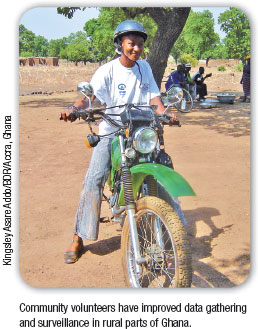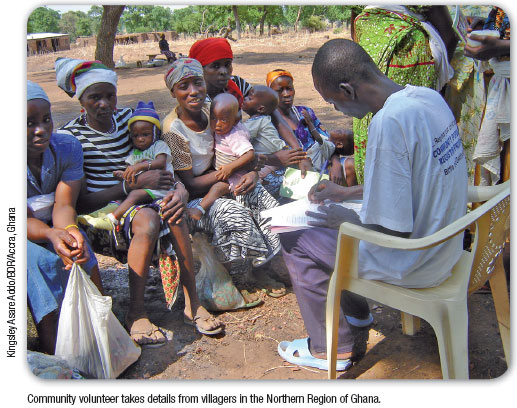NEWS
Volunteers vital for counting births and deaths in Ghana
Ghana is going high-tech to improve community-based vital registration, which is essential for the design and planning of health programmes. Mawusi Afele reports.
For Ghanaian civil servant Ofori Asante every day begins with an insurmountable challenge: how to document all the births and deaths taking place in the Northern Region of his country, an area extending 70 384 square kilometrers and containing a sparsely distributed population of two and a half million people.
"The Northern Region is very large, the roads are very bad and the villages are very far apart," says Asante, who works in the regional Births and Deaths Registry based in the city of Tamale. His task is made all the more difficult because of a chronic lack of funding, staff and equipment. For Kingsley Asare Addo, principal assistant registrar of Ghana's Births and Deaths Registry in the capital Accra, this lack of resources is a key reason why only 65% of births and 22% of deaths are registered in this country of 24 million people.
When civil registration started in Ghana in 1888, it covered colonial settlements and a few commercial towns. It was not until 1965, eight years after independence, that the Registration of Births and Deaths Law was passed making provision for compulsory registration for the whole population. But still, today, complete coverage has yet to become a reality in this West African country.
Ghana is one of many developing countries struggling to address their peoples' health needs with an incomplete picture of their health, that is, incomplete data notably on the number of births, deaths and causes of death by age, sex and geographical distribution. Without this information it is impossible to gauge the success of health programmes and to know whether the country is reducing child and maternal mortality, as articulated in the Millennium Development Goals (MDG) 4 and 5. Says Isaac Adams, director of Research Statistics and Information at the health ministry, "we need this information to design programmes and interventions to reduce untimely and preventable deaths".

To increase registration rates, the country's Births and Deaths Registry has waived fees, is training community health nurses and volunteers to register births and deaths and has launched public awareness campaigns, including a births and deaths registration day celebration. As part of a pilot project, community-based volunteers extract and forward birth and death registration details to the local or district registrar in six regions.
Despite these initiatives, Addo believes the Births and Deaths Registry could do even better if it were properly funded. "We should be registering about 90% of births," he says, noting that while registration of births has improved, it is sometimes late. "People remember to register only when they need the birth certificates to complete an official document," Addo says.
Meanwhile death registration is still lacking and the cause of a death cannot be reliably determined when it occurs at home and a doctor is not present. Instead, health officials rely on interviews with the families about the deceased's symptoms and passing, known as verbal autopsy. While less accurate than physician certification, verbal autopsy is useful in communities where deaths occur at home.
Civil registration, including births and deaths registration, not only creates the legal documents that establish individual rights, but is also the basis for statistics used in the design and management of health and development programmes.
While civil registration is not the only data source available to health officials, it is of particular value because - unlike censuses and household surveys - it is universal, compulsory and continuous, explains Andrews Lamptey, head of vital statistics at the Ghana Statistical Service. Without this uninterrupted stream of up-to-date information, statisticians, such as Lamptey, are reduced to making projections based on assumptions, while health officials can find themselves confronted by major health crises with very little information on which to base an effective response.
That is precisely what happened in 1996-97, when northern Ghana was hit by a serious outbreak of cerebrospinal meningitis. "A post-epidemic evaluation of the situation described the surveillance system in the Northern Region as 'porous'," says Dr Andrew Seidu Korkor, programme manager of Ghana's national guinea-worm eradication programme. Most deaths occurred outside the few scattered health facilities in the vast region, so health officials could not provide the government with accurate and timely information that could be used to tackle the outbreak. Moreover, in many cases, the information they did obtain on the epidemic was from journalists reporting on the ground. "That was a very difficult moment," Korkor says.
As a result, the Northern Regional Health Authorities expanded the surveillance system for guinea-worm disease (dracunculiasis) to include reporting on other diseases and events, including births and deaths. This approach was subsequently adopted as a national strategy for disease surveillance and data gathering.
Today the Ghana Health Service uses these volunteers to monitor a wide range of illnesses, as well as to gather data on infant and maternal deaths. Their volunteer work is of particular value in complementing facility-based surveillance, Korkor says, because there are so few health facilities. In order to make this data gathering process more effective, volunteers use a "tally sheet" showing images that are easily understood by all, regardless of language or culture.
Ghanaians are not accustomed to recording health events such as abortions, stillbirths and maternal deaths immediately after they occur, Korkor says, and one of the important functions of the community volunteers is to make sure that such events are promptly recorded. Suspected causes of death - such as meningitis, cholera, anthrax, tetanus, measles and snake bite - are also documented, providing important epidemiological data.
However, while community volunteers have improved data gathering and surveillance in Ghana, there are still huge challenges to overcome, Korkor says. In some remote areas, there are not enough community volunteers and some of them are illiterate. In other areas, where there are many volunteers, lack of funds to provide adequate training has resulted in volunteers losing motivation and becoming inactive.
Under-five child mortality in Ghana has decreased since 1990 from an estimated 118 deaths for every 1000 children to 76 in 2008, but this progress is not considered sufficient to achieve MDG 4, the goal to reduce child deaths by two thirds by 2015. But these figures cited in the Countdown 2015 report are estimates. A really precise picture of child health in Ghana and many other countries is not possible without more reliable health data. That is where community-based surveillance comes in.
Now the Ghanaians are teaming up with international partners, the Noguchi Memorial Institute of Medical Research, the Johns Hopkins University, the Canadian International Development Agency (CIDA), the United Nations Children's Fund (UNICEF) and the World Health Organization (WHO) to implement a Rapid Mortality Monitoring project. Pilots in three districts in the Northern Region started in April this year. The three-year project will study how well community volunteers report the births and deaths of children aged less than five years. It is one of several similar projects in Africa, including others (which are supported by CIDA) in Ethiopia, Malawi, Mali and Niger.

The community volunteers in Ghana will be provided with mobile phones to notify their district supervisors of a birth or death of a child aged less than five. The supervisor will then visit the volunteers with a laptop to pick up the relevant information. By using electronic data transfer, storage and management for vital statistics reporting, errors and delays that are inevitable in paper-based systems can be reduced.

"The approach capitalizes on the work done in births and deaths registration and community-based surveillance that has been supported by the Births and Deaths Registry and the Ghana Health Service," says Dr Daniel Kojo Arhinful of the Noguchi Memorial Institute of Medical Research in Accra, expressing a view shared by Dr Mark Amexo of WHO's Health Metrics Network, who says that the Northern Region was chosen for several reasons including its well established community disease surveillance.
Amexo believes that information technology has a huge part to play in improving civil registration in poor countries and regions. "Obstacles to the civil registration system can be leap-frogged through innovations that include leveraging information technology to overcome systems and infrastructural barriers and improve efficiency of the programmes and guarantee quality information and statistics," he says. Amexo also hopes that information technology will serve to extend the national civil registration system beyond its current physical limits. "Trained volunteers can use mobile phones to report back information, which can then be fed into the national system," he says. Amexo is particularly keen to see an improvement in registration rates for deaths. "If you don't know about a death and the cause of that death, how can you hope to plan effective public health interventions to prevent a similar occurrence in future?" he asks. 
